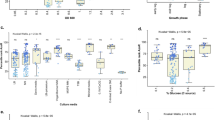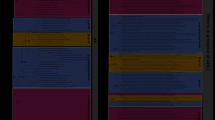Abstract
whi genes, named after the mutations turning Streptomyces coelicolor colonies into white, exist largely in Actinomyces and Mycobacterium. whiB genes, a subclass of whi, involve in wide range of events, such as cell division, spore formation, nutrient starvation, pathogenesis, antibiotic resistance, and stress sense. To better understand the role of this family in physiology and pathology in the important pathogen—Mycobacterium tuberculosis, WhiB and WhiB-like proteins function and structures of were bioinformatically dissected. Seven WhiB proteins can be found in M. tuberculosis genome, most are highly conserved. Based on the data mining of published microarray profiling of wild type and mutants transcriptome response to diverse treatments, a regulatory network of whiB is established. Some findings from this network are obvious. WhiB2 and WhiB7 might be key nodes in drug resistance, WhiB3 might involve in the maintenance of redox homeostasis. These works provide new Mycobacterium persistence and virulence hypothesis for future experimental validation.



Similar content being viewed by others
References
Chater, K. F. (1972). A morphological and genetic mapping study of white colony mutants of Streptomyces coelicolor. Journal of General Microbiology, 72, 9–28.
Denhengst, C., & Buttner, M. (2008). Redox control in actinobacteria. Biochimica et Biophysica Acta (BBA)—General Subjects, 1780, 1201–1216.
Soliveri, J. A., Gomez, J., Bishai, W. R., & Chater, K. F. (2000). Multiple paralogous genes related to the Streptomyces coelicolor developmental regulatory gene whiB are present in Streptomyces and other actinomycetes. Microbiology, 146(Pt 2), 333–343.
Alam, M. S., Garg, S. K., & Agrawal, P. (2009). Studies on structural and functional divergence among seven WhiB proteins of Mycobacterium tuberculosis H37Rv. FEBS Journal, 276, 76–93.
Suhail Alam, M., & Agrawal, P. (2008). Matrix-assisted refolding and redox properties of WhiB3/Rv3416 of Mycobacterium tuberculosis H37Rv. Protein Expression and Purification, 61, 83–91.
Garg, S. K., Suhail Alam, M., Soni, V., Radha Kishan, K. V., & Agrawal, P. (2007). Characterization of Mycobacterium tuberculosis WhiB1/Rv3219 as a protein disulfide reductase. Protein Expression and Purification, 52, 422–432.
Jakimowicz, P. (2004). Evidence that the Streptomyces developmental protein WhiD, a member of the WhiB family, binds a [4Fe–4S] cluster. Journal of Biological Chemistry, 280, 8309–8315.
Crack, J. C., Smith, L. J., Stapleton, M. R., Peck, J., Watmough, N. J., Buttner, M. J., et al. (2010). Mechanistic insight into the nitrosylation of the [4Fe–4S] cluster of WhiB-like proteins. Journal of American Chemical Society, 133(4), 1112–1121.
Smith, L. J., Stapleton, M. R., Fullstone, G. J., Crack, J. C., Thomson, A. J., Le Brun, N. E., et al. (2010). Mycobacterium tuberculosis WhiB1 is an essential DNA-binding protein with a nitric oxide-sensitive iron–sulfur cluster. Biochemistry Journal, 432, 417–427.
Flardh, K., Findlay, K. C., & Chater, K. F. (1999). Association of early sporulation genes with suggested developmental decision points in Streptomyces coelicolor A3(2). Microbiology, 145(Pt 9), 2229–2243.
Soliveri, J., Vijgenboom, E., Granozzi, C., Plaskitt, K. A., & Chater, K. F. (1993). Functional and evolutionary implications of a survey of various actinomycetes for homologues of two Streptomyces coelicolor sporulation genes. Journal of General Microbiology, 139, 2569–2578.
Shen, X. L., Dong, H. J., Hou, X. P., Guan, W. J., & Li, Y. Q. (2008). FtsY affects sporulation and antibiotic production by whiH in Streptomyces coelicolor. Current Microbiology, 56, 61–65.
Jakimowicz, D., Mouz, S., Zakrzewska-Czerwinska, J., & Chater, K. F. (2006). Developmental control of a parAB promoter leads to formation of sporulation-associated ParB complexes in Streptomyces coelicolor. Journal of Bacteriology, 188, 1710–1720.
Molle, V., Palframan, W. J., Findlay, K. C., & Buttner, M. J. (2000). WhiD and WhiB, homologous proteins required for different stages of sporulation in Streptomyces coelicolor A3(2). Journal of Bacteriology, 182, 1286–1295.
Gomez, J. E., & Bishai, W. R. (2000). whmD is an essential mycobacterial gene required for proper septation and cell division. Proceedings of National Academy of Sciences of the United States of America, 97, 8554–8559.
Raghunand, T. R., & Bishai, W. R. (2006). Mapping essential domains of Mycobacterium smegmatis WhmD: insights into WhiB structure and function. Journal of Bacteriology, 188, 6966–6976.
Rybniker, J., Nowag, A., van Gumpel, E., Nissen, N., Robinson, N., Plum, G., et al. (2010). Insights into the function of the WhiB-like protein of mycobacteriophage TM4—a transcriptional inhibitor of WhiB2. Molecular Microbiology, 77, 642–657.
Choi, W. W., Park, S. D., Lee, S. M., Kim, H. B., Kim, Y., & Lee, H. S. (2009). The whcA gene plays a negative role in oxidative stress response of Corynebacterium glutamicum. FEMS Microbiology Letters, 290, 32–38.
Kim, T.-H., Park, J.-S., Kim, H.-J., Kim, Y., Kim, P., & Lee, H.-S. (2005). The whcE gene of Corynebacterium glutamicum is important for survival following heat and oxidative stress. Biochemical and Biophysical Research Communications, 337, 757–764.
Geiman, D. E., Raghunand, T. R., Agarwal, N., & Bishai, W. R. (2006). Differential gene expression in response to exposure to antimycobacterial agents and other stress conditions among seven Mycobacterium tuberculosis whiB-like genes. Antimicrobial Agents and Chemotherapy, 50, 2836–2841.
Steyn, A. J., Collins, D. M., Hondalus, M. K., Jacobs, W. R., Jr, Kawakami, R. P., & Bloom, B. R. (2002). Mycobacterium tuberculosis WhiB3 interacts with RpoV to affect host survival but is dispensable for in vivo growth. Proceedings of National Academy of Sciences of the United States of America, 99, 3147–3152.
Ehrt, S., & Schnappinger, D. (2009). Mycobacterial survival strategies in the phagosome: Defence against host stresses. Cellular Microbiology, 11, 1170–1178.
Shiloh, M. U., Manzanillo, P., & Cox, J. S. (2008). Mycobacterium tuberculosis senses host-derived carbon monoxide during macrophage infection. Cell Host & Microbe, 3, 323–330.
Singh, A., Crossman, D. K., Mai, D., Guidry, L., Voskuil, M. I., Renfrow, M. B., et al. (2009). Mycobacterium tuberculosis WhiB3 maintains redox homeostasis by regulating virulence lipid anabolism to modulate macrophage response. PLoS Pathogens, 5, e1000545.
Morris, R. P., Nguyen, L., Gatfield, J., Visconti, K., Nguyen, K., Schnappinger, D., et al. (2005). Ancestral antibiotic resistance in Mycobacterium tuberculosis. Proceedings of National Academy of Sciences of the United States of America, 102, 12200–12205.
Burian, J., Ramon-Garcia, S., Sweet, G., Gomez-Velasco, A., Av-Gay, Y., & Thompson, C. J. (2011). The mycobacterial transcriptional regulator whiB7 links redox homeostasis and intrinsic antibiotic resistance. Journal of Biological Chemistry, 287(1), 299–310.
Kang, S. H., Huang, J., Lee, H. N., Hur, Y. A., Cohen, S. N., & Kim, E. S. (2007). Interspecies DNA microarray analysis identifies WblA as a pleiotropic down-regulator of antibiotic biosynthesis in Streptomyces. Journal of Bacteriology, 189, 4315–4319.
Alspaugh, J. A., Pukkila-Worley, R., Harashima, T., Cavallo, L. M., Funnell, D., Cox, G. M., et al. (2002). Adenylyl cyclase functions downstream of the Galpha protein Gpa1 and controls mating and pathogenicity of Cryptococcus neoformans. Eukaryotic Cell, 1, 75–84.
Rickman, L., Scott, C., Hunt, D. M., Hutchinson, T., Menendez, M. C., Whalan, R., et al. (2005). A member of the cAMP receptor protein family of transcription regulators in Mycobacterium tuberculosis is required for virulence in mice and controls transcription of the rpfA gene coding for a resuscitation promoting factor. Molecular Microbiology, 56, 1274–1286.
Qamra, R., Mande, S. C., Coates, A. R., & Henderson, B. (2005). The unusual chaperonins of Mycobacterium tuberculosis. Tuberculosis (Edinb), 85, 385–394.
Rifat, D., Bishai, W. R., & Karakousis, P. C. (2009). Phosphate depletion: a novel trigger for Mycobacterium tuberculosis persistence. Journal of Infectious Diseases, 200, 1126–1135.
Primm, T. P., Andersen, S. J., Mizrahi, V., Avarbock, D., Rubin, H., & Barry, C. E., 3rd. (2000). The stringent response of Mycobacterium tuberculosis is required for long-term survival. Journal of Bacteriology, 182, 4889–4898.
Al-Attiyah, R., Madi, N., El-Shamy, A. S., Wiker, H., Andersen, P., & Mustafa, A. (2006). Cytokine profiles in tuberculosis patients and healthy subjects in response to complex and single antigens of Mycobacterium tuberculosis. FEMS Immunology and Medical Microbiology, 47, 254–261.
Manganelli, R., Provvedi, R., Rodrigue, S., Beaucher, J., Gaudreau, L., & Smith, I. (2004). Sigma factors and global gene regulation in Mycobacterium tuberculosis. Journal of Bacteriology, 186, 895–902.
Manganelli, R., Dubnau, E., Tyagi, S., Kramer, F. R., & Smith, I. (1999). Differential expression of 10 sigma factor genes in Mycobacterium tuberculosis. Molecular Microbiology, 31, 715–724.
Samuel, L. P., Song, C. H., Wei, J., Roberts, E. A., Dahl, J. L., Barry, C. E., 3rd, et al. (2007). Expression, production and release of the Eis protein by Mycobacterium tuberculosis during infection of macrophages and its effect on cytokine secretion. Microbiology, 153, 529–540.
Agarwal, N., Raghunand, T. R., & Bishai, W. R. (2006). Regulation of the expression of whiB1 in Mycobacterium tuberculosis: Role of cAMP receptor protein. Microbiology, 152, 2749–2756.
Garg, S., Alam, M. S., Bajpai, R., Kishan, K. R., & Agrawal, P. (2009). Redox biology of Mycobacterium tuberculosis H37Rv: protein–protein interaction between GlgB and WhiB1 involves exchange of thiol-disulfide. BMC Biochemistry, 2009(10), 1.
Beinert, H., Holm, R. H., & Munck, E. (1997). Iron–sulfur clusters: Nature’s modular, multipurpose structures. Science, 277, 653–659.
Jervis, A. J., Crack, J. C., White, G., Artymiuk, P. J., Cheesman, M. R., Thomson, A. J., et al. (2009). The O2 sensitivity of the transcription factor FNR is controlled by Ser24 modulating the kinetics of [4Fe–4S] to [2Fe–2S] conversion. Proceedings of National Academy of Sciences of the United States of America, 106, 4659–4664.
Arjomandzadegan, M., Owlia, P., Ranjbar, R., Farazi, A. A., Sofian, M., Sadrnia, M., et al. (2011). Rapid and simple approach for identification of Mycobacterium tuberculosis and M. bovis by detection of regulatory gene whiB7. Acta Microbiologica et Immunologica Hungarica, 58, 65–74.
Li, T. M. S., & Fu, M. (2007). Genome-wide exploration of the drug action of capreomycin on Mycobacterium tuberculosis using Affymetrix oligonucleotide GeneChips. Infection, 2007(54), 277–284.
Acknowledgments
This study was supported by National megaproject for key infectious disease (Grant No. 2012ZX10003-003), the Fundamental Research Funds for the Central Universities (Grant No. XDJK2009A003, XDJK2011D006), National natural science foundation (Grant No. 81071316), Excellent PhD thesis fellowship of southwest university (Grant Nos. kb2010017 and ky2011003), New Century Excellent Talents in Universities (NCET-11-). The authors are grateful for suggestions from Wang Xiao-zhen and Liao Guo-jian.
Author information
Authors and Affiliations
Corresponding author
Rights and permissions
About this article
Cite this article
Zheng, F., Long, Q. & Xie, J. The Function and Regulatory Network of WhiB and WhiB-Like Protein from Comparative Genomics and Systems Biology Perspectives. Cell Biochem Biophys 63, 103–108 (2012). https://doi.org/10.1007/s12013-012-9348-z
Published:
Issue Date:
DOI: https://doi.org/10.1007/s12013-012-9348-z




